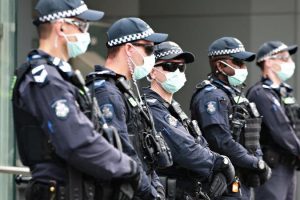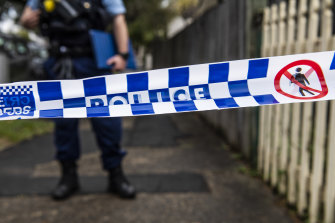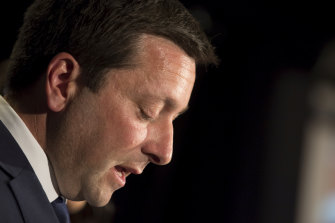Boosting police numbers will not reduce people’s fear of crime

Globally, crime rates are falling, particularly for property and violent crime. As professors Don Weatherburn and Sara Rahman demonstrate in their recent book The Vanishing Criminal, crime rates began to drop quite significantly in the early 2000s in Australia. In the last decade, the number of robberies, homicides and assaults have fallen considerably across every jurisdiction in the country.
Despite declines in rates of serious and violent crime, we have not witnessed the same decline in reports of fear of crime. This paradox has fascinated criminologists for years. Just how many people are afraid of crime, and why are they so afraid of crime when crime rates are dropping? To answer these questions, we need to consider how we measure fear of crime and understand what influences people’s perceptions of crime.
Despite declines in rates of serious and violent crime, we have not witnessed the same decline in reports of fear of crime.Credit:iStock
Many surveys rely on a single question that asks how safe people feel walking around their neighbourhood at night. It turns out many people are not so keen on walking around at night. But does this mean they are truly fearful of crime? Evidence suggests this is not the case.
Our recent study examined people’s fear of crime in Victoria. Of the 2862 Victorians we interviewed, we found about 43 per cent expressed worry about at least one type of crime. Those who worried about crime were between 45-59 years of age and those who reported previous victimisation.
People living in regional areas reported significantly less worry about crime than those living in or around the city. Not surprisingly, those living in high crime neighbourhoods were more likely to report feeling worried about crime.
Drilling into the data reveals further insights. When we asked how often people felt worried, we found most people only felt worried a handful of times across a 12-month period, and a minority of our sample worried intensely. This supports other research that finds a small number of people have persistent and significant worries about crime.
A small number of people have persistent and significant worries about crime.Credit:Louise Kennerley
So what drives worry for those who do not worry frequently or intensely? It depends on how they perceive crime and their risk of becoming a victim. Certainly, high crime rates and visible cues of disorder (such as the presence of graffiti, loitering or evidence of drug use) influence crime perceptions. Studies consistently find a correlation between the actual crime rate and perceived crime. Yet, there remains a gap between crime perceptions and the reality of crime that cannot be explained by crime incidents.
Research in Australia and elsewhere finds that levels of neighbourhood disadvantage and the ethno-racial composition of an area shape residents’ perceptions of crime. In Australia, certain groups are consciously or subconsciously associated with a wide range of social problems including violence and disorder. The mere presence of some groups is enough to trigger implicit biases among residents, and these biases in turn distort perceptions of neighbourhood crime and disorder.
Shared distortions or collectively held stereotypes of groups as “undesirable” not only stigmatise these groups, but they stigmatise the places where they live. These distortions are often exacerbated through political and media rhetoric. This was clearly evidenced in the 2018 law-and-order election campaign in Victoria.
In our forthcoming book Place, Race and Politics: The Anatomy of a Law and Order Crisis, we chart the unrelenting media and political focus on African Australians as a crime problem leading up to the 2018 Victorian election. We demonstrate the rise of media and political interest in so-called “African gangs” and how sharply this interest waned after the election. We also reveal how damaging the racialised framing of “crime” was (and continues to be) for African communities in Victoria.
Opposition Leader Matthew Guy concedes after the 2018 election.Credit:Chris Hopkins
As fear of crime is, at least in part, shaped by biased perceptions about particular people and particular places, and is not solely attributable to actual criminal incidents, increasing police presence or reducing visible signs of disorder will not be enough to narrow the gap between perceived and actual crime risk.
A recent report by The Age revealed that Victorian Police have increased the numbers of police considerably in the last decade. This may have some crime prevention effect and there may be some people who are comforted by the presence of police. However, the likely consequence of increased policing efforts will be an increased number of contacts between young people, people of colour, people who are homeless and the criminal justice system.
Reducing subjective fears about crime requires a different approach. Evidence suggests increasing community cohesion is a powerful way to mitigate ethno-racial bias and decrease perceptions of crime. Creating opportunities for positive neighbourly exchange and reducing anxieties when meeting others from different cultural and social backgrounds may enhance greater social cohesion.
Media outlets and politicians also have an important role to play. Focusing on what brings communities together is likely to encourage people to work collaboratively together to solve local problems.
In contrast, perpetuating stereotypes and misrepresenting crime trends will only heighten fear and anxiety, leading to greater social divisions that are harmful for those being stigmatised. This approach will also erode community trust, ultimately hindering local crime prevention efforts.
Rebecca Wickes is professor in criminology at Monash University.
Most Viewed in National
From our partners
Source: Read Full Article



